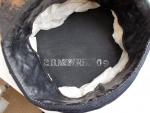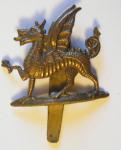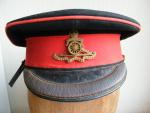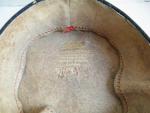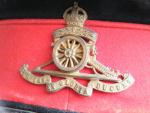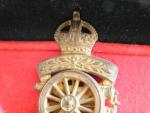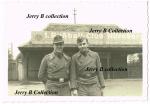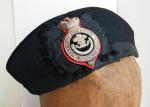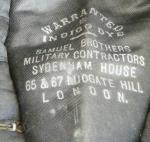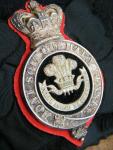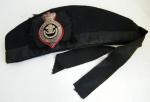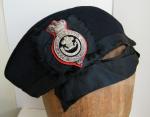-
Posts
527 -
Joined
-
Last visited
Content Type
Profiles
Forums
Blogs
Gallery
Events
Store
Everything posted by Jerry B
-
Adding one more picture of the bn markings as part of it was missed on this very rare pre great war other ranks forage cap. I very carefully removed the badge for a photo and interestingly it has the long slider seen on badges during the early Edwardian period that were phased out about the same time as this cap was issued in 1909.
-
A WWI field grade officers forage cap for the RA territorial force, 1908-1917. The makers went out of business in 1917 and were well known suppliers of headgear and swords etc prior to their demise. The cap is sadly missing most of its chinstrap but other wise is in pretty good condition for its age and has the RA TF gilt officers badge with laurel leave upper scroll rather than the Ubique seen on normal RA badges. The maker of the cap, Hamburger, Rogers & co were well known military outfitters who had been in existence for many years, originally established in 1750, 1796 R. and H. Hewetson. 1814 Hamburger and Co. 1827 Hamburger, Harwood and Co. 1839 Hamburger, Rogers and Co. then from 1841 when Rogers joined as Hamburger, Rogers & Co, Kings st, London, until they went out of business in 1917, though some sources claim Rogers joined in 1839. They were best known for supplying swords and headgear, though originally they were renown suppliers of lace for the Royal family and for military uniforms.
-
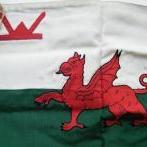
Great Britain Royal Navy Displays
Jerry B replied to SimonLMoore's topic in Great Britain: Militaria: Badges, Uniforms & Equipment
When you can Simon would be fine. I knew the RN used them as did the Marines I think and by ground troops in NI in the 70's. -
Mervyn, the first one is for the Ngbandi tribe and is only one just shown with a montage of 3 views. The 2nd as you state is thought to be a throwing spear and is probably a Zulu type, though I am not at all any sort of expert on these so I have my information from other people. http://www.zyama.com/ngbandi/pics..htm
-
Hi Stuart, the early type forage caps really do look the part and I have yet to add one to my collection, though I have recently been picking up items from nearer that period, with a few WWI period examples and a Late victorian Glengarry for the the Welsh. I noticed a couple of good looking Forage caps of this type on the bay recently, but not taken the plunge yet as the prices are a bit more than I am used to paying for headgear.
-

Great Britain Royal Navy Displays
Jerry B replied to SimonLMoore's topic in Great Britain: Militaria: Badges, Uniforms & Equipment
Excelent displays Simon. What is the helmet next to the white top visor, a tankers lid? Any chance of some detail pics of the headgear? -

Side Cap
Jerry B replied to paul kennedy's topic in Great Britain: Militaria: Badges, Uniforms & Equipment
Circa WWII as Mike has already stated, I am not sure when they stopped wearing these, but in theory the British stopped wearing the khaki side cap in 43-44 when the GS cap was introduced and I assume the NZ would have done the same. -

SS Kantine crockery
Jerry B replied to Jock Auld's topic in Germany: Third Reich: Uniforms, Headwear, Insignia & Equipment
Jock, I find the knocking of other forums that takes place on WRF and WAF rather pathetic and unproductive and as many members are on both it all seems a bit odd. A period image of the back of one perhaps? I have to admit that my first thought would be to be wary, and as it is not something I look for these days, it probably matters little what I think, but the imperfection is not what I would expect, that said earlier period transfer decorated wares often have mistakes on them, I have some Napoleon plates with errors on them. -

SS Kantine crockery
Jerry B replied to Jock Auld's topic in Germany: Third Reich: Uniforms, Headwear, Insignia & Equipment
The missprint on the Reich plate certainly seems to attract a lot of negative comments, though some seem to like it, but it is not what I would expect to see from the period. Probably one of those that will also attract differing opinions until solid proof can be found either way. -

Great Britain Home Guard
Jerry B replied to Jock Auld's topic in Great Britain: Militaria: Badges, Uniforms & Equipment
The way items travel the world should not really surprise us, as even back in the day souveneers were taken back home or swapped etc and more recently especially since the rise of the net anything from any period and from any country can be found h=just about anywhere these days. I bought this photo only yesterday in west Wales, how it got there is anyones guess and could be an interesting tale or more mundane, we will never know. Looks a good example, a nice pick up. -
An officers Glengarry cap, which during the period was worn by most units of British infantry, officers had silk trim and OR's were leather trimmed but like the officers version had silk tails. On OR's version there was often not a backing for the badge, though this example has a red backing patch and the rosette that became common for all ranks in the later period, when this type of cap became something only worn by Scottish units to this day. The badge is in silver which denotes it was for an officer in a Volunteer battalion of the Welsh Regiment and dates to the period 1881 to 1896, though it is likely to be from nearer the end of the period, as it has the correctly translated version of the motto. This is a fairly rare cap, being more than circa 120 years old and as a collector of both headgear and Welsh items, I am very pleased and somewhat surprised to have picked it up.
-

Great Britain F-S dagger
Jerry B replied to gregM's topic in Great Britain: Militaria: Badges, Uniforms & Equipment
Looks good Greg, a nice used example. -

Grenadier Guards Insignia.
Jerry B replied to leigh kitchen's topic in Great Britain: Militaria: Badges, Uniforms & Equipment
Very nice, both are stunning, the scarlet looks to be in very good condition. Very good to see a forage cap from that period.





